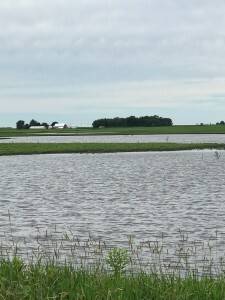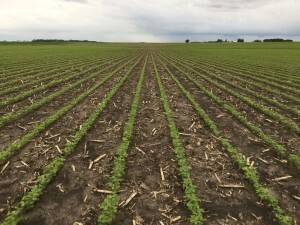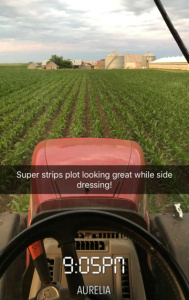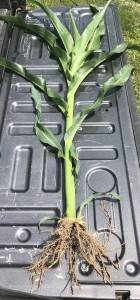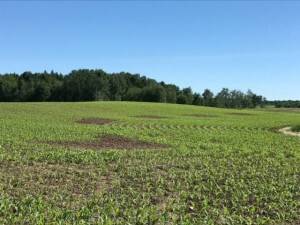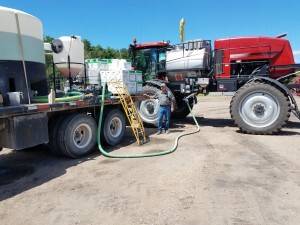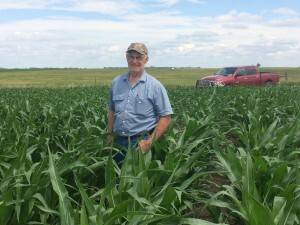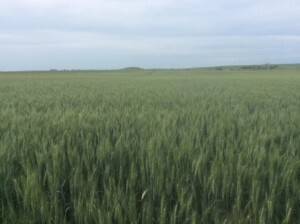EASTERN IOWA
Jerry Broders
Crops are looking pretty good in Eastern Iowa. Post applications are being applied. Always follow label instructions with all herbicides.
CENTRAL IOWA
Bryan Rohe
Growers north of Highway 210 have experienced heavy rain, causing extremely soggy soils. The rain we have got has come extremely fast, dumping three to six inches at a time.
NORTHEAST IOWA & SOUTHEAST MINNESOTA
Craig Haaland
Crops look pretty good overall as you can see from this field of Latham® L 2228 R2. We’ve received a total of about an inch of rain over the past few days, which is making it challenging for farmers to get spraying done.
WEST NORTH CENTRAL IOWA
Bart Peterson
Farmers in my territory received a large amount of rain last Thursday. A dealer near Palmer, IA had 5 inches on his farm. As you can see from the pictures, there is a lot of standing water in this area.
NORTH CENTRAL IOWA & SOUTH CENTRAL MINNESOTA
Cory Greiman
Excessive spring rains in North Iowa means some ground, like this field near Cylinder, didn’t get planted to corn as planned.
NORTHWEST IOWA
Darin Chapman
We look forward to seeing the results from these Latham® SuperStrip plots! Judging by the looks of our Latham LH 5245 VT2 PRO RIB and LH 5635 VT2 PRO, they might be repeat winners just like in the 2017 F.I.R.S.T. Trials.
WESTERN IOWA & EASTERN NEBRASKA
Larry Krapfl
SOUTHERN WISCONSIN
Greg Mair
We could have done without the three to five inches of rain that fell overnight on Monday across southern Wisconsin. Excessive moisture this spring has growers replanting some acres around the state. Keep in mind, Latham offers a great replant program on corn, soybeans, and alfalfa. Many growers found it a real value this spring. Call me to learn more about the 100% replant policy.
At V8, LH 5095 VT2 PRO is standing strong in the hills of Hazel Green. Armed with good roots and even better stalks, it is a solid product to have on your acres when margins are tight and you must manage risk.
NORTHERN WISCONSIN
Joey Salter
Northern Wisconsin crops have been under stress this past week due to lack of rain. Corn is starting to curl in most areas of the region. Now is a good time to get out and scout for unwanted weeds, as well as for equipment malfunctions. In the picture below, the technology in the tractor and planter had a glitch. When they started planting, the planter would roll several feet before it would plant but the monitor would show it planting. If detected early enough, this can be fixed to prevent all of the fields from looking like this. Unfortunately for this grower, all of his acres have skips.
SOUTHERN MINNESOTA
Jay Nelson
Soils are wet from Svea to Slayton, Montevideo to Mountain Lake, and Cosmos to Comfrey. Such a long time with saturated soil has resulted in corn that is yellow and stunted. We’re also seeing compaction and poor rooting where seed were planted in unfit soils. Some of these fields may require additional nitrogen. Your best bet is to start with a healthy plant like our tried-and-true LH 5215 VT PRO RIB and the newer LH 5245 VT PRO RIB.
NORTHERN MINNESOTA
Ken Highness
At M&R Farms in Beltrami, Minnesota, Mike Skaug loads the sprayer for a post-pass on a field of Latham® L 0739 R2X before the June 20 deadline.
SOUTHEAST SOUTH DAKOTA
Ramie Coughlin
A shift in the forecast has brought us back to normal temperatures with chances of rain all week. This week many farms in Southeast South Dakota (SESD) got some much needed rain while others received way too much. Some areas are forecast to receive as much as 5 inches, and farmers in those areas are still trying to get crop in the ground. On the brighter side, many crops are looking fantastic. Most corn fields are taller than knee high and canopied. Also this week, we saw a lot of hay/alfalfa down and picked back up. Because we missed getting a late frost and received great moisture early this spring, the first cuttings are awesome! Many soybean fields are starting to look pretty. Notice the white flash in the corn. It’s just cosmetic and was likely caused from chemical coupled with hot weather that caused the plants to grow really quickly. I have seen many fields with flashing throughout the state. The good news is that it’s not yield robbing.
NORTHEAST SOUTH DAKOTA
James Keltgen
Beautiful picket fence stand in this field of LH 4452 RR and LH 4454 VT2 PRO RIB that was planted in drought conditions on May 6 in northern Hand County.
SOUTHEAST NORTH DAKOTA
Gary Geske
Over the weekend, my grandson and I did a little crop scouting. Now is a great time to get ready to side dress additional nitrogen if needed. You can tell by the big smile on our agronomist in training that he approves of Latham 3397 VT2 PRO RIB.
EASTERN NORTH DAKOTA
Brian McNamee
What a difference from last year in western North Dakota! At this time last year, farmers were abandoning their wheat due to drought. Hay cuttings were 10 to 20% of normal tonnage, and corn fields were barely alive. Precipitation has been very good recently, and GDUs (growing degree units) are presently higher than the 5-year average. After last year’s drought, this is setting up to be just the year we need.

